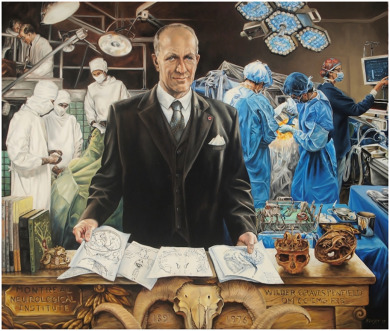Since 1821, McGill University has climbed the ranks and established itself among Canada’s high-performing research institutions. It is no understatement that McGill professors and alumni went on to excel in their respective fields, particularly in scientific domains.
Ernest Rutherford, who was a professor of experimental physics at McGill, conducted world-renowned research on the concept of radioactivity. In 1908, he was awarded the Nobel Prize in Chemistry for his work, which included coining “radioactive half-life” and distinguishing between alpha and beta radiation. Past these remarkable achievements, The McGill Tribune has compiled a list of lesser-known accomplishments that have irrevocably altered and advanced various scientific disciplines.
- The discovery of radon in 1899
Anyone who has taken basic high school chemistry courses will have come across this noble gas in the periodic table. With an atomic number of 86 and an atomic weight of 222, radon sits just below xenon, and forms as a result of the radioactive decay of uranium. Radon was the fifth radioactive element to be discovered, with the first four being uranium, thorium, radium and polonium. Rutherford, after whom the physics building on campus is named, made yet another groundbreaking discovery when he identified the noble gas alongside fellow McGill professor Robert B. Owens.
- The development of the first artificial cell
Biological cells are the building blocks of life: A group of cells are arranged into tissues, which form the organs that make up nearly every part of our bodies. In 1957, Thomas Chang, a then-undergraduate student in the Faculty of Science, engineered the world’s first artificial cell that imitates one or more actions of a biological cell. Chang developed an artificial cell that was able to carry haemoglobin as efficiently as a red blood cell does.
- The first internet search engine
Imagine having thousands of files stored on a computer with no way to easily sift through them to find a specific result. Fortunately, search engines exist to avoid this issue. A search engine probes the information stored on a computer to pick up the specific data the user requests. Examples of search engines include web search engines like Google or Yahoo, for example, and are designed to find and display information that was already stored on the World Wide Web. The first web search engine was developed by Alan Emtage in 1990, a postgraduate student at the School of Computer Science, after he was tasked, along with a team of other students and staff, to connect McGill to the internet.
- The first veterinary pathology course
Often dubbed the “father of modern medicine,” Sir William Osler completed his medical studies at McGill, receiving his MDCM degree at the age of 22 in 1872. He went on to complete his postgraduate training and returned to McGill in 1874 to pursue professorship. Osler was the first professor to teach a course on veterinary pathology in North America with the aim of furthering his students’ understanding of the origin and development of diseases. He later joined the University of Pennsylvania faculty, became one of the four founding fathers of the Johns Hopkins School of Medicine, and established the first formal residency program there.
- The invention of Plexiglass
Plexiglass, also known as acrylic, is a chemical compound invented by William Chalmers, PhD ‘30. The material became widely used in the manufacturing of airplane windows during the Second World War and has also seen a revival throughout the COVID-19 pandemic—where it was quickly implemented in vaccination centres and grocery stores to curb the transmission of the virus. Due to its strength and durability, plexiglass is typically sold as a shatter-resistant alternative to glass. Common applications of plexiglass include aquariums walls, building windows, and greenhouse panels.
- The discovery of cytokine interleukin-2
Cytokines are a family of small proteins secreted by cells that send messages to the immune system to perform a certain function, thus playing a pivotal role in regulating the body’s immune response. The ‘interleukin-2’ hormone entered scientific discourse when a team of researchers were studying the impact of retroviruses on human disease; the hormone was necessary for the maintenance of T-cells in the lab. This cytokine, later referred to as ‘interleukin-2,’ was discovered by McGill researcher and Royal Victoria Hospital’s surgeon-in-chief Dr. Lloyd D. Maclean in 1965.
- The creation of MUSIC/SP
Punch cards, physical pieces of paper with lines of code punched into them, were once used to store digital data. However, the Multi-User System for Interactive Computing/System Product (MUSIC/SP), formerly known as “McGill University System for Interactive Computing,” was invented as a time-sharing operating system that allowed students and university staff to enter and extract information from the modern, newly developed terminals. Released in 1972, MUSIC/SP was able to expand globally. By the time the operating system became obsolete due to more efficient methods of data storage, it had already reached 250 research institutions and schools.
- The invention of the Montreal Procedure
The Montreal Procedure, used to treat epilepsy patients, was developed in 1952 by renowned neurosurgeon Wilder Penfield, a then-professor at McGill and founder of the Montreal Neurological Hospital and Institute along with neurologist Herbert Jasper, who was a professor of experimental neurology. Epilepsy is characterized by groups of nerve cells signalling in an abnormal manner, causing seizures. The Montreal Procedure is an epilepsy treatment that attacks the nerve cells that cause these seizures. During the operation, patients are given a local anesthetic, thus remaining conscious throughout the procedure. The surgeon would then use electrical brain stimulation and let the patient inform them of the sensation they receive from such stimulation, allowing the surgeon to identify and remove the tissues affected by the seizure.








